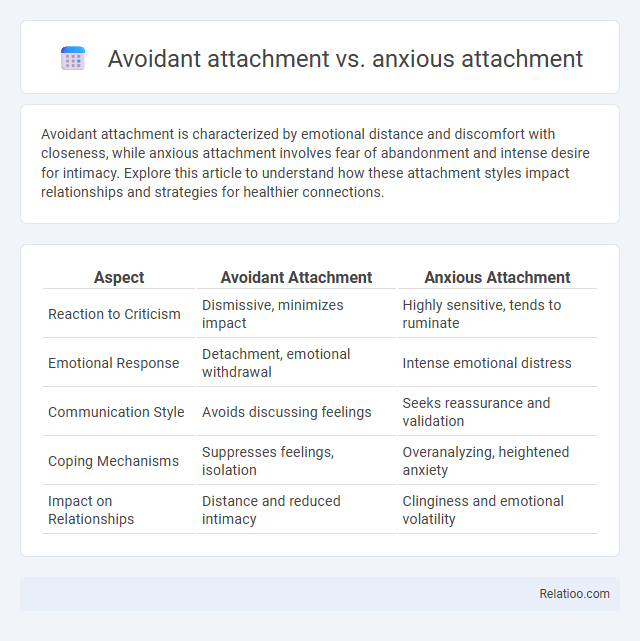Avoidant attachment is characterized by emotional distance and discomfort with closeness, while anxious attachment involves fear of abandonment and intense desire for intimacy. Explore this article to understand how these attachment styles impact relationships and strategies for healthier connections.
Table of Comparison
| Aspect | Avoidant Attachment | Anxious Attachment |
|---|---|---|
| Reaction to Criticism | Dismissive, minimizes impact | Highly sensitive, tends to ruminate |
| Emotional Response | Detachment, emotional withdrawal | Intense emotional distress |
| Communication Style | Avoids discussing feelings | Seeks reassurance and validation |
| Coping Mechanisms | Suppresses feelings, isolation | Overanalyzing, heightened anxiety |
| Impact on Relationships | Distance and reduced intimacy | Clinginess and emotional volatility |
Understanding Attachment Styles: Avoidant vs Anxious
Avoidant attachment is characterized by a strong desire for independence and discomfort with closeness, often leading individuals to suppress emotional needs and avoid intimacy. Anxious attachment involves a heightened sensitivity to rejection and a persistent fear of abandonment, resulting in clinginess and constant reassurance-seeking in relationships. Understanding these attachment styles helps in recognizing patterns of emotional regulation and interpersonal dynamics, essential for improving communication and fostering secure, healthy connections.
Core Traits of Avoidant Attachment
Avoidant attachment is characterized by a strong desire for independence, discomfort with closeness, and difficulty trusting others, often leading to emotional distance in relationships. Unlike anxious attachment, which involves fear of abandonment and excessive need for reassurance, avoidant individuals suppress emotions and avoid intimacy to protect themselves from potential rejection. Core traits include emotional self-sufficiency, reluctance to rely on others, and a preference for maintaining personal space over deep emotional connection.
Key Characteristics of Anxious Attachment
Anxious attachment is characterized by a persistent fear of abandonment, heightened emotional sensitivity, and a constant need for reassurance in relationships. You may experience intense worry about your partner's availability and responsiveness, leading to clinginess and difficulty trusting others. Unlike avoidant attachment, which involves emotional distance and self-reliance, anxious attachment focuses on seeking closeness and fear of rejection.
Childhood Origins of Attachment Patterns
Childhood origins of attachment patterns reveal that avoidant attachment typically develops from caregivers who are emotionally unavailable or dismissive, leading children to suppress their need for closeness. Anxious attachment arises when caregivers are inconsistent or unpredictable, causing children to become hyper-aware and clingy to secure their bond. Understanding your early relational experiences helps identify which attachment pattern influences your adult relationships and emotional responses.
How Avoidant and Anxious Types Respond to Intimacy
Avoidant attachment types often respond to intimacy by maintaining emotional distance and emphasizing independence, as they fear losing autonomy or being engulfed by close relationships. Anxious attachment types seek excessive closeness and reassurance due to fears of abandonment, often displaying heightened sensitivity to signs of rejection. Your understanding of these differing responses to intimacy can improve relationship dynamics and communication.
Communication Differences in Each Attachment Style
Avoidant attachment exhibits communication marked by emotional distance, reluctance to share feelings, and a preference for self-reliance, often leading to minimal verbal expression during conflicts. Anxious attachment involves heightened emotional expression, frequent reassurance-seeking, and fear of abandonment, resulting in more intense and sometimes overwhelming communication patterns. Secure attachment fosters open, balanced communication with clear expression of needs and emotions, promoting healthy conflict resolution and emotional bonding.
Common Relationship Dynamics Between Avoidant and Anxious Partners
Avoidant attachment is characterized by a preference for emotional distance and self-reliance, while anxious attachment involves a heightened need for closeness and reassurance, creating a push-pull dynamic in relationships. You may find that avoidant partners withdraw when overwhelmed, triggering anxious partners to seek constant validation, which can lead to cycles of tension and misunderstanding. Understanding these common relationship dynamics helps in developing healthier communication strategies and emotional regulation techniques tailored to both avoidant and anxious attachment styles.
Impact of Attachment Styles on Emotional Regulation
Avoidant attachment often leads to emotional suppression and difficulty expressing feelings, resulting in challenges with emotional regulation and interpersonal intimacy. Anxious attachment is associated with heightened emotional reactivity and difficulty managing stress due to fears of abandonment and excessive need for reassurance. Secure attachment fosters effective emotional regulation through balanced expression and responsiveness, which positively influences mental health and relationship satisfaction.
Strategies for Healing and Growth
Effective strategies for healing avoidant attachment include practicing vulnerability through safe emotional expression and building trust gradually in relationships. Anxious attachment responds well to mindfulness techniques that reduce anxiety and improving communication skills to express needs clearly and confidently. Individuals with disorganized attachment benefit from trauma-informed therapy that addresses unresolved fears and integrates self-regulation practices to foster emotional stability and secure bonding.
Seeking Professional Help for Attachment Issues
Seeking professional help for attachment issues involves tailored therapeutic approaches depending on the attachment style, with avoidant attachment benefiting from interventions that foster emotional openness and trust-building. Individuals with anxious attachment responses often require therapy focused on enhancing self-esteem and developing secure relational patterns through consistent support and validation. Consulting a mental health professional skilled in attachment theory ensures personalized strategies that address the underlying fears and behaviors characteristic of each attachment style, promoting healthier interpersonal relationships.

Infographic: Avoidant attachment vs Anxious attachment
 relatioo.com
relatioo.com